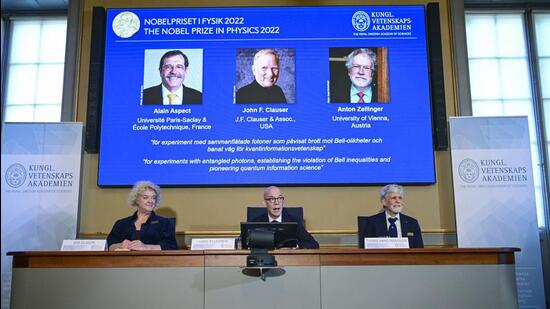Deciphering quantum secrets leads to a Nobel
It is for their work on quantum entanglement that Alain Aspect, John Clauser and Anton Zeilinger shared the Nobel Prize in Physics announced on Tuesday.
New Delhi: Albert Einstein described the concept as “spooky action at a distance”. And Erwin Schrödinger, known for the cat that is alive and dead at the same time, described quantum entanglement as the most important trait of quantum mechanics.

It is for their work on quantum entanglement that Alain Aspect, John Clauser and Anton Zeilinger shared the Nobel Prize in Physics announced on Tuesday. The citation acknowledged them “for experiments with entangled photons, establishing the violation of Bell inequalities and pioneering quantum information science”.
Why it matters
Before getting into entanglement and Bell inequalities, it is necessary to understand what quantum mechanics is about, and why it is important. It is the study of the properties of nature, just like classical physics, but at the scale of atoms and subatomic particles, where many of the laws of classical physics cease to apply.
In the era of quantum information science, knowledge of the subject is key to building quantum computers, the next generation of computing, and managing the transfer and storage of quantum information.
Traditional computers utilise the laws of classical physics. They store information in combinations of 0 or 1; for example, the string 01100001 represents the character ‘a’ in lowercase.
Quantum computers, as the name suggests, seek to exploit the laws of quantum physics. They store information in quantum bits, or qubits, which can be 0 and 1 at the same time, just like Schrödinger’s cat is alive and dead at the same time. Quantum mechanics accounts for the probabilities of the information being both 0 and 1.
The higher the number of qubits, the more the information stored. All this gives quantum computers exponentially higher processing speed than traditional computers.

Quantum entanglement
To explain quantum entanglement, the website of the California Institute of Technology uses an analogy: the “Jim twins”, who were famous in the US for leading seemingly parallel lives after being separated soon after birth in the 1940s. Reunited at age 39, they learnt that their sons, wives and childhood pets all had the same names, while the twins themselves had similar preferences in many things.
In quantum mechanics, two or more particles (or photons) can exist in a shared state, regardless of how far apart they are, just like the Jim twins. This is quantum entanglement. When two particles are in an entangled state, you can measure a property of one particle and determine the corresponding measurement on the other particle, without checking.
From Einstein to Bell
How could your knowledge of the state of one particle predict the state of another particle when there is apparently no interaction between the two? In 1935, Einstein and his colleagues Boris Podolsky and Nathan Rosen examined this question and described what is known as the “EPR paradox”.
EPR postulated that there may be “hidden variables” that account for the entanglement. The quantum mechanics theory is incomplete, they proposed: it does not completely describe physical reality.
As it turned out, quantum mechanics is correct. The Nobel-winning physicists established this with their research on a concept known as “Bell’s inequalities”.
This, again, can be understood with an analogy. The accompanying illustration, adapted from a statement released by the Nobel Foundation, shows a machine that throws out balls of opposite colours in opposite directions. When Bob catches a black ball, he knows Alice has caught a white one, and vice versa.
According to classical physics, the balls contain hidden information about what colour to show. According to quantum physics, they were grey until either Bob or Alice looked at them, at which point they turned either black or white.
So, which of these is true? The late physicist John Stewart Bell found that a type of experiment can determine whether the world follows quantum physics, or whether hidden variables are at play. If the experiment is repeated many times and certain results are within a specific value, this is due to hidden variables. If they exceed that value, it means quantum physics rules.
This threshold value is a “Bell’s inequality”. If it could be shown to be violated, it would mean quantum physics is true. And this is what Aspect and Clauser did.
Nobel winners’ work
In 1972, Clauser, who now runs a company in California, and his late student Stuart Freedman built an apparatus that emitted two entangled photons at a time, and showed a result that violated a Bell inequality, thus validating quantum mechanics. But there were limitations, with certain things preset, and an observer could question: what if the experiment selected certain other particles with different results?
Aspect, then a doctoral student and now with Université Paris-Saclay and École Polytechnique, built a new version of the set-up with better measurements, which closed the loopholes in Clauser’s experiment, reconfirming the validity of quantum physics.
In 1997, Zeilinger, now with the University of Vienna, conducted experiments to demonstrate yet another interesting aspect: quantum teleportation. If the particles in an entangled pair travel in opposite directions, and one of them meets and gets entangles with a third particle, they enter a new shared state. The third particle loses its identity, with its original properties transferred to the solo particle from the original pair.
All Access.
One Subscription.
Get 360° coverage—from daily headlines
to 100 year archives.



HT App & Website







